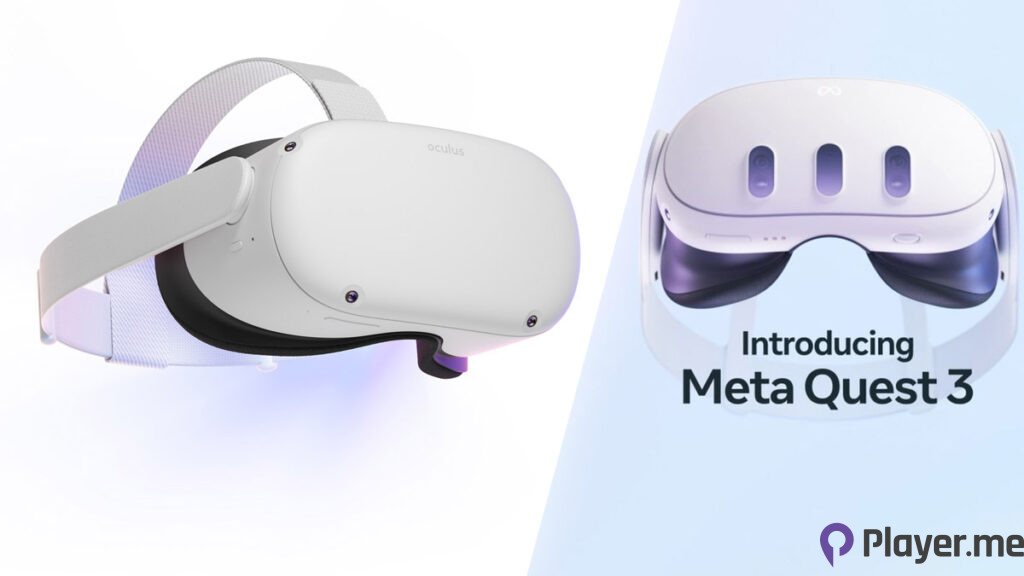The VR landscape is getting more heated as incredibly ambitious VR headsets like Apple Vision Pro enter the ring. While there will clearly be more in the future, it’s important to analyze the current best options to pick the one that suits you best. That’s where our guide offers everything to know about Meta Quest 3 vs. Quest 2.
A new iteration of tech is usually much better as it should expand upon its predecessor’s shortcomings. However, the factors change when we talk about VR headsets. For instance, Quest 2 still offers great value despite naturally lacking some of the aspects found in Quest 3. That being said, it can still be perfect for you based on what you look for.
Without further ado, let’s dive in and compare Meta Quest 3 to Meta Quest 2.
Meta Quest 3 vs. Quest 2: Which Is Better?

Meta Quest 3 is much better than Quest 2 in a wide range of aspects like better resolution, intuitive passthrough, and more capacity. However, Meta Quest 2 is still one of the best VR headsets out there. While it doesn’t have the aforementioned aspects, it does come with more than enough VR capabilities that will make anyone happy, for sure.
On top of those, Quest 2 also has a quite strong argument against its successor. Unlike the shiny new iteration, Quest 2 comes at a more affordable price while providing you the fundamental VR experience at an impressive level. That’s why it’s the best option for those who are on a budget. It’s also still amazing if you want to play some of the best VR horror games.
The Differences Between Meta Quest 3 vs. Quest 2
Here’s a list of differences between the predecessor and the successor or Meta Quest 3 vs. Quest 2. While Quest 2 is still an impressive headset that can play some of the best VR games, Quest 3 has lots of winner features.
- The resolution in Quest 3 is 2064×2208, whereas it’s 1832×1920 in Quest 2.
- The successor runs on a Snapdragon XR2 Gen 2 processor, whereas its predecessor has the base XR2 model.
- Quest 3 also comes with an increase in storage, with 512 GB models being available as well. The max storage on Quest 2, on the other hand, is 256 GB.
Another strong argument is in favour of the successor when it comes to the Meta Quest 3 vs. Quest 2 comparison. That’s because the new iteration boasts a new controller design that feels more spacious, thanks to the new design. The controllers now have haptic feedback as well, which is arguably one of the best gimmicks the next-gen gaming technologies have introduced so far.
Meta Quest 3 vs. Quest 2: Is It Worth Upgrading?

You might want to upgrade to Quest 3 from Quest 2 as it offers a series of very compelling upgrades. For instance, it offers a whopping 30% increase in resolution and wider field of view. On top of those solid improvements, the new VR headset from Meta also offers two more cameras, 2 GB mora RAM memory, and nearly 40% more battery power.
There is no doubt that these are much-needed improvements. That’s why Quest 3 feels like the best way to enter virtual reality if you’re really serious about this verticality of gaming. In short, Quest 3 is the perfect answer to the question Meta Quest 3 vs Quest 2 if you’re serious about your virtual and augmented reality endeavours.
If you just want to have a solid experience in VR games, you might as well go with Quest 2. Its passthrough might not be the best out there, but it’s not essential to upgrade to Quest 3 if your main activity on VR is casual gaming.
Final Thoughts
In short, the comparison of Meta Quest 3 vs. Quest 2 has many different factors, primarily the cost and what you look for in a VR headset. As mentioned earlier, the predecessor still delivers the virtual wonders you would like to see. That’s why it’s still a great idea to grab a Quest 2.
That being said, Quest 3 is the best option for those who aren’t on a budget and are willing to reach new heights in virtual and augmented realities. Meta‘s highly-anticipated VR headset will not have you look back at other options. However, it’s also contested by another player, Apple Vision Pro.
Author Profile
- My journey into the world of video games began at four, when I was first introduced to arcade machines in 1996. Over the past decades, I've been fortunate enough to witness the incredible evolution of gaming, as it has grown from a niche hobby to a thriving art. Today, I'm dedicated to creating content that celebrates all genres of games. We will talk about them at Player.me.





